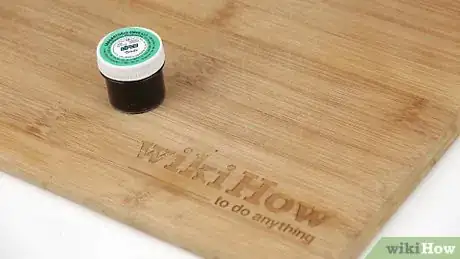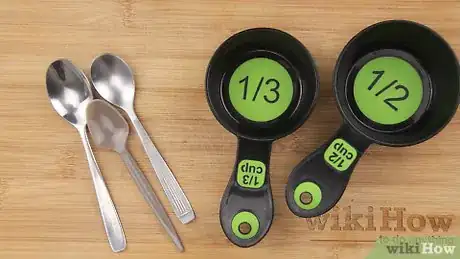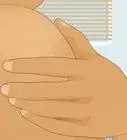This article was co-authored by wikiHow Staff. Our trained team of editors and researchers validate articles for accuracy and comprehensiveness. wikiHow's Content Management Team carefully monitors the work from our editorial staff to ensure that each article is backed by trusted research and meets our high quality standards.
This article has been viewed 20,170 times.
Learn more...
Bath bombs bring a lovely fragrance and color to a soak in the tub. Adding color to a homemade bath bomb is simple, and you can use a variety of colorants, including dyes, micas, and oxides. These materials can be added while the bath bomb is in its liquid phase or dry phase. A bath bomb in its liquid phase means the ingredients are all together but haven’t yet formed any particular shape. When a bath bomb is in its dry phase, it has already become a solid. Bath bombs are easy to colorize and make taking a bath even more enjoyable!
Steps
Adding Color During the Liquid Phase
-
1Determine which colorants mesh well before adding them to the bath bomb mixture. If you want to create a multi-colored bath bomb, you have to keep in mind how the colors interact with one another. If you mix too many similar-looking colorants together, the end result gets muddied as opposed to multi-colored.[1]
- You can just use a single color if that's what you want!
- It's okay to mix multiple colorants, but putting too many colors together could dilute the final product.
- Complementary colors tend to mix well. These are colors that sit directly across from each other on a color wheel, including violet and yellow or orange and blue.
-
2Use water-based colorants. The simplest way to add color to your bath bombs is to mix it in during the bomb’s liquid phase. Your colorant must be water-soluble in order for this to work. Dyes are best for this, as micas and oxides are not water soluble. You can pick up most colorants at an arts and crafts store or order them online.[2]
- Oxides come in powdered form. If you want to add them to the liquid phase of your bath bomb, you’ll need to mix them with a liquid. Instead of water, go for liquid vegetable glycerin. Take about ¼ teaspoon of your oxide and add a few drops of glycerin to it. Stir well before mixing it with the liquid bath bomb.
- Mica is a mineral that is found all over the world. It is sterilized, ground into tiny particles, and can be dyed in any color. Like with oxides, mixing Mica with liquid glycerin makes it easier to mesh with the liquid phase of a bath bomb.
Advertisement -
3Add the colorant to the mixture. If you are using a dry colorant that is soluble in water, add enough water to make it roughly equal to half a teaspoon. Remember to mix it thoroughly with the bath bomb materials.[3]
- Half a teaspoon is just a starting point, as you can always add more water later.
- If you’re using oxides or micas, don’t worry about adding more water.
-
4Include the fragrance oil after applying the colorant. It’s your choice for how you want the finished product to smell! Pick whichever fragrance oil you’d like; there are dozens of scents available.[4]
- Scents include Coastal Rain, Moonstone and Champagne
-
5Shake the contents well to ensure the color is well spread. After thoroughly shaking, mix the wet and dry phrases together. The colorant should disperse evenly throughout the bath bomb, as adding the material during the liquid phase gives the bath bomb a solid color.[5]
- To prevent tub stains, add Polysorbate 80 to the bath bombs. It doesn't allow the bath bomb materials to stick to the sides of your tub. You can buy it at stores like Walmart or Target or simply purchase some online.
Working in Colorants During the Dry Phase
-
1Measure colorants carefully using kitchen utensils. The brightness of the colorants can decrease as you make the bath bomb. This is why it is important to measure the colorants using the instruments you have in your kitchen. Finding the right balance of color lets you make bright, eye-catching bath bombs.[6]
- If bath bombs are too darkly-colored, the bathwater will become deeply pigmented. If the bath bombs are too light in color, the bathwater’s color will not change very much.
-
2Add colorant during the first part of the dry phase for a speckled look. People trying for a bath bomb that is textured and bursts with color should consider this method. While this is a more difficult way to add color to a bath bomb, it can create some gorgeous patterns.[7]Advertisement
-
3Take oxide or mica and mix directly with the dry bath bomb materials. Since oxides and micas come in powdered form, adding them directly to the dry phase of a bath bomb is the easiest way to use them.[8]
- For a cool effect, get a powder sprayer, which is a small bottle used to spray dry powder instead of liquid. Spray the powdered material right onto the bath bomb to make the end result sparkle!
-
4Fuse the liquid colorant with Epsom salt before mixing it with the rest of the contents. Epsom salt grains are large and hold color extremely well. Put Epsom salt in a bowl and add a few drops of colorant. Stir the mixture with a whisk and add it to the remaining dry ingredients.
- Some of the salt dissolves as you whisk it, but most of it keeps its shape and takes on the color.
References
- ↑ https://www.soapqueen.com/bath-and-body-tutorials/tips-and-tricks/color-palette-tips-color-resources/
- ↑ https://www.diynatural.com/soap-colorants-pigments-oxides-micas/
- ↑ https://www.soapqueen.com/bath-and-body-tutorials/blooms-berries-bath-bombs/
- ↑ https://www.soapqueen.com/bath-and-body-tutorials/tips-and-tricks/essential-oils-vs-fragrance-oils/
- ↑ https://www.mostcraft.com/best-colorants-bath-bombs/
- ↑ https://www.hunterlab.com/blog/color-pharmaceuticals/best-color-measurement-system-bath-bombs-multi-colored-soaks/
- ↑ https://www.diynatural.com/soap-colorants-pigments-oxides-micas/
- ↑ https://www.diynatural.com/soap-colorants-pigments-oxides-micas/




















































